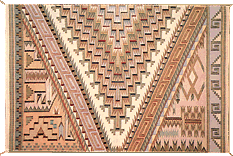For the past 100 plus years the weavings were
identified by region or style; therefore, the weaver's name was
not a factor in determining the value of the weaving . . . its
value was determined by quality alone.
It's possible this could change. Along with
individualized designs, we have seen an increasing number of
weavers exhibiting their work in competitions and shows and marketing
their weavings directly to galleries, and in some cases directly
to the collector . . . eliminating the historic role of the trader
altogether.
Isn't this the kind of "marketing" an
artist is supposed to do? To promote his or her name? After all,
the better-known the artist, the higher the price they can demand
for their art.
However, there is some debate on this subject.
No honorable trader, dealer or collector would deny the weaver
the credit, nor the fame, for what she has accomplished. But
there are those who believe that Navajo weaving is a pure art
form, and to distort the values by putting a premium on specific
weavers' artwork would be a huge disservice to the entire market—past,
present and future.
Will collecting Navajo weavings become an
elitist sport or will "lay people" still be able
to buy a quality Navajo weaving?
Will the young people still be enthusiastic
to learn the art?
Who will buy the "beginner rugs" if
the trader no longer plays a role?
How will the average buyer/potential collector
know who is famous and who is not?
How will weavers respond to legitimate demands
that the gallery expects from an artist, for example an exclusivity
contract, consignment, advertising arrangements and gallery appearances
by the artist?
With all the shows, competitions, gallery appearances
and time on the road selling her work to various galleries, what
will happen to the traditional way of life that is important
and expected of her?
We must also consider the possibility that,
if the weavers do not achieve recognition for individual artistry,
their interest in expanding the art may wane for lack of reward.
For the first time in history, Navajo weaving could be at a standstill!
Most likely, we will always have the classic Teec
Nos Pos, Ganado, Two Grey Hills, Storm, Yei,
etc, being woven for the contemporary market. This type of
weaving is too deeply embedded into the market to ever lose
their appeal. The question that remains is what will the "new" styles
resemble, and who will be responsible for their creation and
promotion?
Fortunately, the answers are not mine to give,
just to ponder. Nor is there a rush to have these questions answered
today. If there is one thing we have learned from the past, it
is that the art of Navajo weaving does not have any brakes
. . . but it does have a steering wheel. And for the first 200
plus years the Navajo artisans did a fine job at the wheel! For
the last 100 plus years, it was the trader who steered us well.
We can now only trust that whoever takes the wheel from here
steers us as well. Based upon what I've seen in the past few
months, it is going to be an interesting ride!
|

